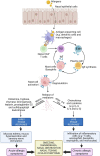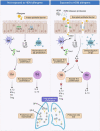Allergic Rhinitis: A Clinical and Pathophysiological Overview
- PMID: 35463011
- PMCID: PMC9021509
- DOI: 10.3389/fmed.2022.874114
Allergic Rhinitis: A Clinical and Pathophysiological Overview
Abstract
Allergic rhinitis (AR) represents a global health concern where it affects approximately 400 million people worldwide. The prevalence of AR has increased over the years along with increased urbanization and environmental pollutants thought to be some of the leading causes of the disease. Understanding the pathophysiology of AR is crucial in the development of novel therapies to treat this incurable disease that often comorbids with other airway diseases. Hence in this mini review, we summarize the well-established yet vital aspects of AR. These include the epidemiology, clinical and laboratory diagnostic criteria, AR in pediatrics, pathophysiology of AR, Th2 responses in the disease, as well as pharmacological and immunomodulating therapies for AR patients.
Keywords: Th2 responses; allergic rhinitis; diagnostic criteria; epidemiology; immunotherapy; pathophysiology.
Copyright © 2022 Nur Husna, Tan, Md Shukri, Mohd Ashari and Wong.
Conflict of interest statement
The authors declare that the research was conducted in the absence of any commercial or financial relationships that could be construed as a potential conflict of interest.
Figures



References
-
- Steelant B, Farre R, Wawrzyniak P, Belmans J, Dekimpe E, Vanheel H, et al. Impaired barrier function in patients with house dust mite-induced allergic rhinitis is accompanied by decreased occludin and zonula occludens-1 expression. J Allergy Clin Immunol. (2016) 137:1043–53.e5. 10.1016/j.jaci.2015.10.050 - DOI - PubMed
Publication types
LinkOut - more resources
Full Text Sources
Research Materials

